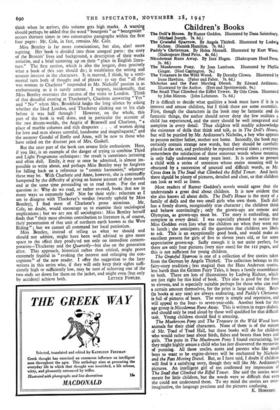Children's Books
IT is difficult to decide what qualities a book must have if it is to interest and amuse children, but I think there are some essentials. First, though the characters in the book may be fantastic and do fantastic things, the author should never deny the few realities a child has experienced, and the story should be well integrated and complete in every detail. Thus children will readily acknowledge the existence of dolls that think and talk, as in The Doll's House, but will be puzzled by Mr. Ardizzone's Nicholas, a boy who appears to possess neither father, mother nor home. Secondly, the book may certainly contain strange new words, but they should be carefully placed in the text, and preferably be repeated several times ; everyone remembers the satisfaction of these sonorous words whose meaning is only fully understood many years later. It is useless to present a child with a series of sentences whose entire meaning will be obscured by a succession of unusual and difficult words, as Mr. Cross does in The Snail that Climbed the Eiffel Tower. And lastly there should be plenty of pictures, detailed and clear, so that children can look as well as listen.
Most readers of Rumer Godden's novels would agree that she understands a great deal about children. It is now evident that she also knows all about dolls. The Doll's House is the story of a family of dolls and the two small girls who own them. Each doll has a firmly drawn, recognisably true character ; the children think and behave convincingly ; only the grown-ups are remote and Olympian, as grown-ups must be. The story is enthralling, and complete in every detail. I was especially pleased to notice that Miss Godden even lists what the children ate when they went out to lunch ; she anticipates all the questions that children are like!) to ask. This is an exceptionally good book, and would make an excellent present for girls of five to eleven years old, or for some appreciative grown-up. Sadly enough it is not quite perfect, for there are only four pictures (very nice ones) for the II2 pages, and this is not sufficient for young children.
The Grateful Sparrow is one of a collection of five stories taken from the German by Angela Thirkell. The collection belongs to the fairy-story tradition ; less magical than the Hans Andersen stories, less harsh than the Grimm Fairy Tales, it bears a family resemblance to both. There are lots of illustrations by Ludwig Richter, which are just right for this kind of book. This also is good for the fives to elevens, and is especially suitable perhaps for those who can read a certain amount themselves, for the print is large and clear. Bears (in books at any rate) are always endearing, and Paddy's Christmas is full of pictures of bears. The story is simple and repetitive, and will appeal to the four- to seven-year-olds. Another book for this age group is Nicodemus Runs Away. This is written in negro dialect, and should only be read aloud by those well qualified for that difficult task. Young children should find it amusing.
The Mushroom Pony and The Treasure in the Wild Wood have animals for their chief characters. None of them is of the stature of Mr. Toad of Toad Hall, but these books will do for children who would rather hear about birds, fishes and beasts than boys and girls. The puns in The Mushroom Pony I found excruciating, but they might highly amuse a child who has just discovered the mysteries of punning. All those uncles, aunts and parents who like small boys to want to be engine-drivers will be enchanted by Nicholas and the Past Moving Diesel. But, as I have said, I doubt if children will find it a satisfying story, though they will like Mr. Ardizzone's pictures. An intelligent girl of ten confirmed my impression of The Snail that Climbed the Eiffel Tower. She said the stories were meant for little children, but the words were so difficult that even she could not understand them. To my mind the stories are over- imaginative, the language precious and the pictures confusing.
K. HORNSBY.




























 Previous page
Previous page